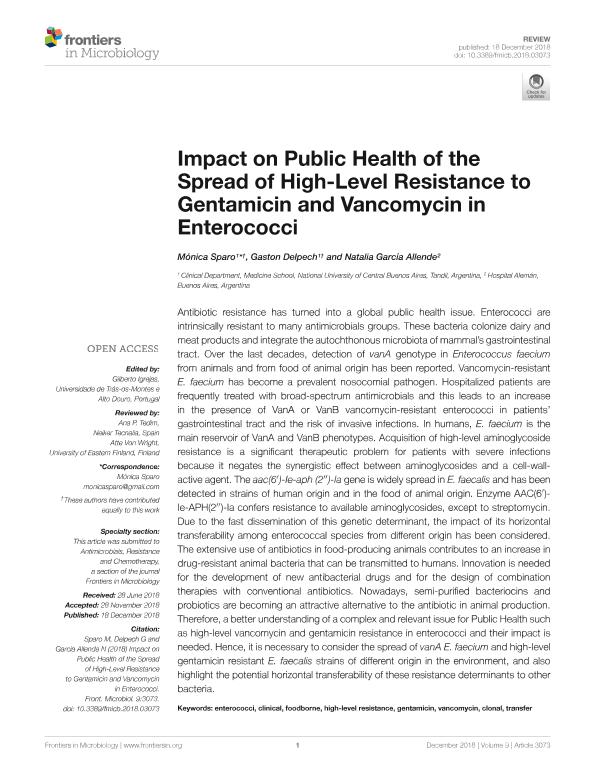Artículo
Impact on public health of the spread of high-level resistance to gentamicin and vancomycin in enterococci
Fecha de publicación:
03/2018
Editorial:
Frontiers Research Foundation
Revista:
Frontiers in Microbiology
e-ISSN:
2235-2988
Idioma:
Inglés
Tipo de recurso:
Artículo publicado
Clasificación temática:
Resumen
Antibiotic resistance has turned into a global public health issue. Enterococci are intrinsically resistant to many antimicrobials groups. These bacteria colonize dairy and meat products and integrate the autochthonous microbiota of mammal’s gastrointestinal tract. Over the last decades, detection of vanA genotype in Enterococcus faecium from animals and from food of animal origin has been reported. Vancomycin-resistant E. faecium has become a prevalent nosocomial pathogen. Hospitalized patients are frequently treated with broad-spectrum antimicrobials and this leads to an increase in the presence of VanA or VanB vancomycin-resistant enterococci in patients’ gastrointestinal tract and the risk of invasive infections. In humans, E. faecium is the main reservoir of VanA and VanB phenotypes. Acquisition of high-level aminoglycoside resistance is a significant therapeutic problem for patients with severe infections because it negates the synergistic effect between aminoglycosides and a cell-wall-active agent. The aac(60)-Ie-aph (200)-Ia gene is widely spread in E. faecalis and has been detected in strains of human origin and in the food of animal origin. Enzyme AAC(60)-Ie-APH(200)-Ia confers resistance to available aminoglycosides, except to streptomycin. Due to the fast dissemination of this genetic determinant, the impact of its horizontal transferability among enterococcal species from different origin has been considered. The extensive use of antibiotics in food-producing animals contributes to an increase in drug-resistant animal bacteria that can be transmitted to humans. Innovation is needed for the development of new antibacterial drugs and for the design of combination therapies with conventional antibiotics. Nowadays, semi-purified bacteriocins and probiotics are becoming an attractive alternative to the antibiotic in animal production. Therefore, a better understanding of a complex and relevant issue for Public Health such as high-level vancomycin and gentamicin resistance in enterococci and their impact is needed. Hence, it is necessary to consider the spread of vanA E. faecium and high-level gentamicin resistant E. faecalis strains of different origin in the environment, and also highlight the potential horizontal transferability of these resistance determinants to other bacteria.
Archivos asociados
Licencia
Identificadores
Colecciones
Articulos(CIVETAN)
Articulos de CENTRO DE INVESTIGACION VETERINARIA DE TANDIL
Articulos de CENTRO DE INVESTIGACION VETERINARIA DE TANDIL
Citación
Sparo, Mónica Delfina; Delpech, Gastón; García Allende, Natalia ; Impact on public health of the spread of high-level resistance to gentamicin and vancomycin in enterococci; Frontiers Research Foundation; Frontiers in Microbiology; 9; 3-2018; 1-10
Compartir
Altmétricas




